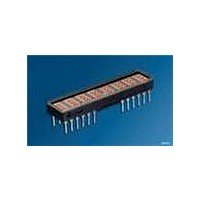IPD2132 OSRAM Opto Semiconductors Inc, IPD2132 Datasheet - Page 12

IPD2132
Manufacturer Part Number
IPD2132
Description
LED Displays 5x7 Super Red 0.2 , 8-CHARACTER
Manufacturer
OSRAM Opto Semiconductors Inc
Series
Alphanumeric Programmable Display™r
Datasheet
1.IPD2131.pdf
(16 pages)
Specifications of IPD2132
Display Type
Dot Matrix
Emitting Color
Hi-Eff. Red
Number Of Digits
8
Digit Size (in)
.2in
Viewing Area Height (mm)
4.8mm
Viewing Area Length (mm)
2.8mm
Package Type
Panel
Operating Supply Voltage (min)
4.5V
Operating Supply Voltage (typ)
5V
Operating Supply Voltage (max)
5.5V
Operating Temperature Classification
Industrial
Operating Temp Range
-55C to 100C
Mounting
Through Hole
Pin Count
24
Total Thickness (mm)
4.6mm
Opto Display Type
Panel
Pattern Type
Dot Matrix
Millicandela Rating
350µcd
Size / Dimension
1.68" L x 0.39" W x 0.21" H (42.7mm x 4.8mm x 5.3mm)
Color
Red
Configuration
5 x 7
Character Size
0.2 in
Illumination Color
High Efficiency Red
Wavelength
635 nm
Maximum Operating Temperature
+ 100 C
Minimum Operating Temperature
- 55 C
Luminous Intensity
350 ucd
Viewing Area (w X H)
2.8 mm x 4.8 mm
Lead Free Status / RoHS Status
Compliant
Voltage - Forward (vf) Typ
-
Internal Connection
-
Lead Free Status / Rohs Status
Details
Other names
Q68000A8836
Control Word
The Control Word is used to set up the attributes required by the
user. It is addressed by setting FL=1, A4=1, A3=0. The Control
Word is an 8 bit register and is accessed using data bits, D7–D0.
See Table „Control Word Access Logic“ (page 12) and Figure
„Control Word Data Definition“ (page 13) for the logic and attrib-
uted control. The Control Word has 5 functions. They are bright-
ness control, flashing character enable, blinking character
enable, self test, and clear (Flash and Character RAMS only).
Brightness Control
Control Word bits, D2–D0, control the brightness of the display
with a binary code of 000 being 100% brightness and 111 being
display blank. See Figure „Control Word Data Definition“
(page 13) for brightness level versus binary code. The average I
can be calculated by multiplying the 100% brightness level I
value by the display’s brightness level. For example, a display set
to 80% brightness with a 100% average I
have an average I
UDC Character Map
Row Data
A2
0
0
0
0
1
1
1
Flash RAM Access Logic
RST
1
1
Control Word Access Logic
RST
1
1
2006-04-04
A1
0
0
1
1
0
0
1
CE
0
0
CE
0
0
A0
0
1
0
1
0
1
0
Row #
1
2
3
4
5
6
7
CC
WR
0
1
WR
0
1
value of 200 mA x 80%=160 mA.
Column Data
C1
D4
5 x 7
Dot Matrix
Pattern
RD
1
0
RD
1
0
C2
D3
FL
0
0
FL
1
1
CC
C3
D2
value of 200 mA will
A4
X
X
A4
1
1
C4
D1
A3
X
X
A3
0
0
C5
D0
CC
CC
A2
Flash RAM Address
for Digits 0–7
Flash RAM Address
for Digits 0–7
A2
Not used for Control
Word
Not used for Control
Word
12
Flash Function
Control Word bit, D3, enables or disables the Flash Function.
When D3 is 1, the Flash Function is enabled and any digit with its
corresponding bit set in the Flash RAM will flash at approximately
2.0 Hz. When using an external clock, the flash rate can be deter-
mined by dividing the clock rate by 28,672. When D3 is 0, the
Flash Function is disabled and the contents of the Flash RAM is
ignored. For synchronized flashing on multiple displays, see the
Reset Section (page 13).
Blink Function
Control Word bit, D4, enables or disables the Blink Function. When
D4 is 1, the Blink Function is enabled and all characters on the dis-
play will blink at approximately 2.0 Hz. The Blink Function will over-
ride the Flash Function if both functions are enabled. When D4 is
0, the Blink Function is disabled. When using an external clock, the
blink rate can be determined by dividing the clock rate by 28,672.
For synchronized blinking on multiple displays, see the Reset Sec-
tion (page 13).
Self Test
Control Word bits, D6 and D5, are used for the Self Test Function.
When D6 is 1, the Self Test is initiated. Results of the Self Test are
stored in bit D5. Control Word bit, D5, is a read only bit. When D5
is 1, Self Test has passed. When D5 is 0, Self Test failed is indi-
cated. The Self Test function of the IC consists of two internal rou-
tines which exercise major portions of the IC and illuminates all of
the LEDs. The first routine cycles the ASCII decoder ROM through
all states and performs a check sum on the out-put. If the check
sum is correct, D5 is set to a 1 (Pass).
The second routine provides a visual test of the LEDs. This is
accomplished by writing checkered and inversed checkered pat-
terns to the display. Each pattern is displayed for approximately
2.0 sec. During the self test function the display must not be
accessed. The time needed to execute the self test function is cal-
culated by multiplying the clock time by 262,144 (typical
time ≈ 4.6 sec.). At the end of the self test, the Character RAM is
loaded with blanks; the Control Word Register is set to zeroes
except D5; the Flash RAM is cleared and the UDC Address Regis-
ter is set to all 1.0s.
A1
A1
A0
A0
IPD2131, IPD2132, IPD2133
D7 D6 D5 D4 D3 D2 D1 D0
D0=Flash Data, 0=Flash Off and 1=Flash On
(Write Cycle)
D0=Flash Data, 0=Flash Off and 1=Flash On
(Read Cycle)
D7 D6 D5 D4 D3 D2 D1 D0
Control Word data for a Write Cycle,
see Figure „Control Word Data Definition“
(page 13)
Control Word data for a Read during a
Read Cycle















